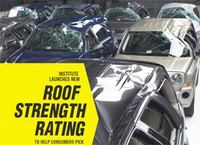IIHS: Roof Strength Study and Ratings
MORE: Complete IIHS Roof Stregnth Report With Rating Charts
MORE: IIHS Roof Strength Crash Video
Roof strength is focus of new rating system; Volkswagen Tiguan, Subaru Forester, Honda Element, and Jeep Patriot earn top marks
ARLINGTON, VA March 24, 2009; The Insurance Institute for Highway Safety is launching a new roof strength rating system to help consumers pick vehicles that will help protect them in rollover crashes. Twelve small SUVs are the first to be put to the test. Only 4 earn the top rating of good. The Volkswagen Tiguan has the strongest rated roof, and the Kia Sportage has the weakest among the 2008-09 models evaluated.
This new rating system is based on Institute research showing that occupants in rollover crashes benefit from stronger roofs. Vehicles rated good must have roofs that are more than twice as strong as minimum federal safety standards require.
The Volkswagen Tiguan, Subaru Forester, Honda Element, and Jeep Patriot earn good ratings. The Suzuki Grand Vitara, Chevrolet Equinox, Toyota RAV4, Nissan Rogue, and Mitsubishi Outlander are rated acceptable. Roofs on the Honda CR-V and Ford Escape are marginal, and the Kia's is poor.
"We anticipate that our roof strength test will drive improved rollover crash protection the same way our frontal offset and side impact consumer test programs have led to better protection in these kinds of crashes," says Institute president Adrian Lund.
Institute research indicates that roofs have gotten stronger during the past few years. Part of the reason is that manufacturers have made structural improvements to earn better front and side ratings in Institute crash tests. Strong A and B pillars help prevent intrusion in these types of crashes and also help hold up the roof.
"It's not surprising that Volkswagen and Subaru earn good ratings in our new roof test because these automakers were among the first to ace our front and side tests," Lund points out.
More than 10,000 people a year are killed in rollovers. When vehicles roll, their roofs hit the ground, deform, and crush. Stronger roofs crush less, reducing the risk that people will be injured by contact with the roof itself. Stronger roofs also can prevent occupants, especially those who aren't using safety belts, from being ejected through windows, windshields, or doors that have broken or opened because the roof has deformed. Roofs that don't collapse help keep people inside vehicles as they roll.
Any vehicle can roll in a crash, but the problem is worse in some kinds of vehicles than others. About 25 percent of occupant deaths in crashes of cars and minivans involve rolling over. For SUVs, this proportion jumps to 59 percent.
The best way to prevent the deaths is to keep vehicles from rolling over in the first place. Electronic stability control is significantly reducing rollovers, especially fatal single-vehicle ones. When vehicles do roll, side curtain airbags help protect the people inside. Belt use is essential.
How roofs are evaluated: In the Institute's roof strength test, a metal plate is pushed against 1 side of a roof at a constant speed. To earn a good rating, the roof must withstand a force of 4 times the vehicle's weight before reaching 5 inches of crush. This is called a strength-to-weight ratio. For an acceptable rating, the minimum required strength-to-weight ratio is 3.25. A marginal rating value is 2.5. Anything lower than that is poor.
The ratings depend on vehicle weight, which in turn depends on options like engine size and 2-wheel versus 4-wheel drive. The Institute bases its ratings on a typical small SUV, which tends to be 4-wheel drive and comes with a 4-cylinder engine and automatic transmission. Heavier and lighter versions of these vehicles are available, and their actual rollover injury risk would vary by small amounts. The ratings provide an indication of the relative risk of similarly equipped vehicles.
The small SUVs that did well have roofs that are 2.5 to 3.5 times stronger than the minimum federal safety standard for roof strength. The National Highway Traffic Safety Administration proposes a new standard but not as tough as the Institute recommends. The agency has argued that upgrading the requirements would have only a limited effect on rollover deaths and injuries. Institute research indicates otherwise.
"Our research shows that a strength-to-weight ratio of 4 reflects an estimated 50 percent reduction in the risk of serious and fatal injury in single-vehicle rollover crashes compared with the current federal standard of 1.5," Lund explains.
Cars have been built to meet the same roof crush standard, Federal Motor Vehicle Safety Standard 216, since 1973. The rule was extended in 1994 to include all passenger vehicles up to a gross weight rating of 6,000 pounds. Many SUVs and pickups are heavier, so they're exempt. In 2005, the government proposed an upgrade to cover these larger vehicles and require the roofs on all passenger vehicles to have a strength-to-weight ratio of 2.5. Many vehicles already meet this ratio and would earn only a marginal rating in the Institute's new roof strength test. A final rule is still pending.
Roof ratings added to award criteria: A good roof strength rating will be a new requirement to earn the Institute's Top Safety Pick award for 2010. This is the second time criteria for this award have been tightened since the first winners were announced in 2005. Availability of electronic stability control became a requirement starting with 2007s.
"Adding Top Safety Pick criteria means we'll see fewer winners in 2010," Lund says. A record 73 vehicles have qualified for the 2009 award so far, and 8 of the 2009 winners are among the 12 small SUVs the Institute just tested for roof strength. However, only 3 of the 8 — the Tiguan, Forester, and Element — have the roof strength to qualify for next year's award. Next the Institute will assess roof strength of minicars and midsize cars.



